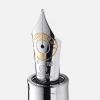Search the Community
Showing results for tags 'dye'.
-
Hi all! I did a little essay on the chemistry of fountain pen inks for extra credit in my AP Chemistry class. I thought you might enjoy reading it as well. Please feel free to let me know if anything is wrong (I don't think there's anything wrong but I know there's chemists lurking on this forum) and enjoy! The Chemistry of Fountain Pen Inks Even in today’s increasingly digital society, writing and print publications remain ubiquitous parts of our daily lives. From completing chemistry homework to reading the newspaper, we are constantly in contact with words on paper. Although the structure of the paper is mostly consistent, even with seemingly different types, the inks used vary greatly and are impressive examples of chemical engineering applied to an important part of daily life. Inks are used for countless applications, but the two most common uses are printing and writing. Printing inks, which create the vibrant pages of textbooks, newspapers, and magazines, however, represent only one part of the ink family. The other, more chemically diverse branch of this family, is writing ink. The chemical makeup of inks has incredible variation between the types of pens the inks are designed for, and even within different inks for the same type of pen. The most strikingly variant and chemically interesting group of writing inks are those designed for use in fountain pens. Due to the feed system used in fountain pens to bring ink to the tip, or nib, of the pen, fountain pen inks must be solutions rather than pigment based like many of their ballpoint peers. The inks for fountain pen use must also be water soluble, not tinctures. This requirement stems from the nature of the material that the pen bodies are made from. Many pens, especially those from the early 20th century, are made from celluloid, ebonites, or other natural plastics, which are soluble in alcohol. Any tincture inks would damage these pens. Because of the unique requirements created by a fountain pen’s feed system and the materials used to make vintage pens, many fountain pen inks are made of several fundamentally similar ingredients. First and foremost, all are made mostly of water, the solvent of the ink. A solute that occurs in nearly all fountain pen inks is a water soluble aniline dye composed of a Nitrite group bound to a phenyl group, forming a basic amine, phenylamine. Although many of these dyes are actually more soluble as tinctures, they are dissolved in water to protect the pen materials, as discussed earlier. Other common solutes are surfactants to increase ink flow, biocide compounds to prevent fungal growth in ink, and glycerin to increase ink viscosity. Despite fundamental similarities and rigid requirements to protect pens, fountain pen inks manage to present a wide range of properties to the consumer. These features include greatly decreased freezing points, total permanence on paper, scents, color changes, and decreased drying times. Inks with lowered freezing points are formed by the addition of solutes that dissolve into multiple ions or ring-based covalent hydrocarbons (in the case of polar covalent solutes). Paper permanence is achieved through the addition of solutes that bond with the cellulose of the paper, ensuring that the ink remains permanently marked on the paper and fraud-proof. Scents are the easiest of the properties to create, made by adding ester based solutes formed by the reaction of carboxylic acid and alcohols to the ink solution. Color changing inks are formed by making an ink with multiple dyes, only one of which forms the type of permanent cellulose bond described earlier. When the ink is rinsed with water, all of the dyes except that which bonds with the cellulose wash away, “changing” the color of the ink on the page. Decreased drying times are created, counterintuitively, by adding higher surfactant levels than usual and increasing flow. This allows the ink to seep into the fibers of the paper faster, and stay wet and smudge-prone for a shorter period of time. Inks remain one of the most important parts of everyday life, and will for the foreseeable future. The chemical diversity is striking across different types of inks, for different applications. For fountain pen inks however, more unites the inks than differentiates them. Yet even with this surface level chemical uniformity, the addition of trace levels of different solutes allows fountain pen inks to come in a vast rainbow of colors and an array of special properties.
-
Who is William Henry Perkin? The discoverer of Mauveine - the first synthetic organic dye. Made from aniline. Guess what? Most inks today are made from aniline dyes. What color is Mauveine? Purple. I thought this was pretty cool. Serendipity. Kind of like Sir William Henry Perkin's discovery. https://en.wikipedia.org/wiki/William_Henry_Perkin https://www.forbes.com/sites/kionasmith/2018/03/12/mondays-google-doodle-celebrates-chemist-sir-william-henry-perkin/
-
The following recipe is a recipe for Lilac Colored fountain pen ink manufactured using water-based dyes. I have not tested this recipe yet, but I have ordered all the materials and plan on testing it as soon as they arrive. I will then update the recipe with the results. The recipe was created by me, using my knowledge about fountain pens, other FPN users' experiences, and my knowledge about chemistry from my AP Chemistry Course. I chose to make Lilac ink to match my Dark Lilac Lamy Safari that will be arriving shortly. Materials: Procion MX Lilac Cold Water Fabric Dye- The main source of color for the ink and the major dye in the ink. Pure Glycerin- To increase the viscosity of the ink and make it better able to flow like normal pen ink. Germall Preservative- To prevent the formation of SITB and increase the shelf life of the ink. Polysorbate Tween 80 Surfactant- To make the ink flow more easily. Distilled or De-Ionized Water- The main solvent of the ink. Funnel- For easier pouring. Filter Paper- To remove accidental sediments that could clog pens. Cheap Sacrificial Test Pen (I'll be using a Jetpens Chibi)- To run initial tests of the ink. Lots of Paper- To write on with the above pen. Empty 30 mL Ink Bottle(s)- To store your new ink. Blunt Tip Syringe- For the measurement and addition of glycerin. Gloves- In case you have a dinner party later and can't have inky fingers. 50 mL Graduated Cylinder- To measure the water. Centigram Scale- To measure the dyes and glycerin. Safety Goggles- Standard Lab Procedure. Lab Apron- Same as above. 50 mL Beaker- For the initial mixing of the ink. Ring Stand- For the final filtration. Glass Stirring Rods- To mix the parts of the ink. Graduated Pipettes- For the measurement and insertion of the surfactant and biocide. Procedure: 1. Measure out 30 mL of distilled water in a graduated cylinder. Add the water to the 50 mL Beaker using a funnel. 2. Use the Centigram Scale to measure out 2.00g of Procion Dye. Add the dye to the Beaker. Stir until the dye has dissolved in the water using a glass stirring rod. 3. Zero the Centigram scale with the blunt tip syringe on it. Then, use the syringe to pick up 1g of glycerin. Add the glycerin to the beaker, and stir until dissolved using a glass stirring rod. 4.Using Graduated Pipettes, add one drop of Polysorbate Surfactant and one drop of Germall Preservative to the beaker. Use a glass stirring rod to stir until dissolved. 5. Using the beaker, filter paper, and ring stand, filter the contents of the beaker into the Empty Ink Bottle. Ideally and theoretically, there will be no remaining sediment on the filter paper, but this step adds an extra level of security to protect our pens. 6. Ink up a pen and try out the ink, adjusting levels of Surfactant and Dye to match your ideal properties of flow and color saturation. Be gradual, as you can always add more, but if you add too much surfactant the batch is essentially ruined. This recipe is still untested, so I wouldn't go trying it in your pens just yet, but I intend to have the ink made by at the latest June 8th, and will post the results then.
-
Hi, So I have a bit of an odd question. I dye my own wool to spin or felt, and on occasion I use fiber reactive dyes to dye plant based material like bamboo or cotton. I was wondering if I could try using the fiber reactive dye to create my own ink. You use Soda Ash to set the color so it would need to be in the "ink". Will this be an abysmal failure or should I give it a go and see what happens?



